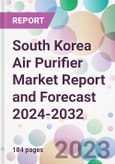According to the report, the South Korea air purifier market is projected to grow at a CAGR of 8.1% between 2024 and 2032 reaching a value of approximate USD 27.71 billion by 2032. Aided by escalating concerns over air quality and a surge in health consciousness among the populace, the market is expected to grow significantly by 2032.
Air purifiers are electronic devices designed to cleanse the air by removing pollutants like dust, pollen, smoke, and allergens. They have gained significant traction in urban settings, where pollution levels often breach safe limits. Given South Korea's metropolitan character, particularly in cities like Seoul and Busan, the need for air purifiers is more pressing than ever.
One of the primary drivers for the South Korea air purifier market growth is the recurrent episodes of 'yellow dust' or Asian Dust, which are seasonal meteorological phenomenon that significantly degrades air quality. These dust storms, stemming from the deserts of Mongolia and China, bring along with them not just sand but also a slew of pollutants and microorganisms. Such events have prompted South Koreans to increasingly invest in air purifiers to ensure a healthier indoor environment.
As per the South Korea air purifier market analysis, the burgeoning realisation of the health implications of indoor pollutants further augments the market growth. Modern South Korean homes, laden with electronic gadgets, often see a buildup of indoor pollutants that can be more detrimental than outdoor pollution. Air purifiers, especially those with HEPA filters and activated carbon, have thus become a staple in many households and offices.
The recent global health crises have also played a significant role in propelling the South Korea air purifier market demand. Amid the pandemic, the emphasis on clean, uncontaminated air has risen manifold. Many consumers now view air purifiers not just as devices that keep away pollutants, but also as essential tools to reduce the risk of airborne diseases.
South Korea's vibrant tech industry and its innovative zeal have led to the development of advanced air purifiers that are not just efficient but also smart. IoT-enabled air purifiers that can be controlled remotely, give real-time air quality readings, and even integrate with smart home systems are gaining popularity. These devices, often sleek in design to match modern Korean home aesthetics, offer a combination of functionality and style and further contribute to the South Korea air purifier market size.
Air purifiers are electronic devices designed to cleanse the air by removing pollutants like dust, pollen, smoke, and allergens. They have gained significant traction in urban settings, where pollution levels often breach safe limits. Given South Korea's metropolitan character, particularly in cities like Seoul and Busan, the need for air purifiers is more pressing than ever.
One of the primary drivers for the South Korea air purifier market growth is the recurrent episodes of 'yellow dust' or Asian Dust, which are seasonal meteorological phenomenon that significantly degrades air quality. These dust storms, stemming from the deserts of Mongolia and China, bring along with them not just sand but also a slew of pollutants and microorganisms. Such events have prompted South Koreans to increasingly invest in air purifiers to ensure a healthier indoor environment.
As per the South Korea air purifier market analysis, the burgeoning realisation of the health implications of indoor pollutants further augments the market growth. Modern South Korean homes, laden with electronic gadgets, often see a buildup of indoor pollutants that can be more detrimental than outdoor pollution. Air purifiers, especially those with HEPA filters and activated carbon, have thus become a staple in many households and offices.
The recent global health crises have also played a significant role in propelling the South Korea air purifier market demand. Amid the pandemic, the emphasis on clean, uncontaminated air has risen manifold. Many consumers now view air purifiers not just as devices that keep away pollutants, but also as essential tools to reduce the risk of airborne diseases.
South Korea's vibrant tech industry and its innovative zeal have led to the development of advanced air purifiers that are not just efficient but also smart. IoT-enabled air purifiers that can be controlled remotely, give real-time air quality readings, and even integrate with smart home systems are gaining popularity. These devices, often sleek in design to match modern Korean home aesthetics, offer a combination of functionality and style and further contribute to the South Korea air purifier market size.
Market Segmentation
The market can be divided based on technology and application.
Market Breakup by Technology
- HEPA (High-Efficiency Particulate Air)
- Activated Carbon
- Ionic Filters
- Others
Market Breakup by Application
- Commercial
- Residential
- Hospitals
- Healthcare Facilities
- Retail Shops and Offices
- Educational Institutions
- Laboratories
- Transport
- Others
- Industrial
Competitive Landscape
The report looks into the market shares, plant turnarounds, capacities, investments, and mergers and acquisitions, among other major developments, of the leading companies operating in the South Korea air purifier market. Some of the major players explored in the report are as follows:- IQAir AG
- LG Electronics
- Blueair
- Koninklijke Philips N.V.
- Samsung Electronics Co., Ltd.
- Coway
- Dyson Limited
- WINIA Electronics Co., Ltd
- Cuckoo Holdings Co., Ltd.
- Xiaomi Corporation
- Others
Table of Contents
1 Preface2 Report Coverage - Key Segmentation and Scope4 Key Assumptions6 Market Snapshot7 Opportunities and Challenges in the Market11 Key Trends and Developments in the Market
3 Report Description
5 Executive Summary
8 South Korea Air Purifier Market Analysis
9 Market Dynamics
10 Competitive Landscape
List of Key Figures and Tables
Companies Mentioned
- IQAir AG
- LG Electronics
- Blueair
- Koninklijke Philips N.V.
- Samsung Electronics Co. Ltd.
- Coway
- Dyson Limited
- WINIA Electronics Co. Ltd
- Cuckoo Holdings Co. Ltd.
- Xiaomi Corporation
Methodology

LOADING...








